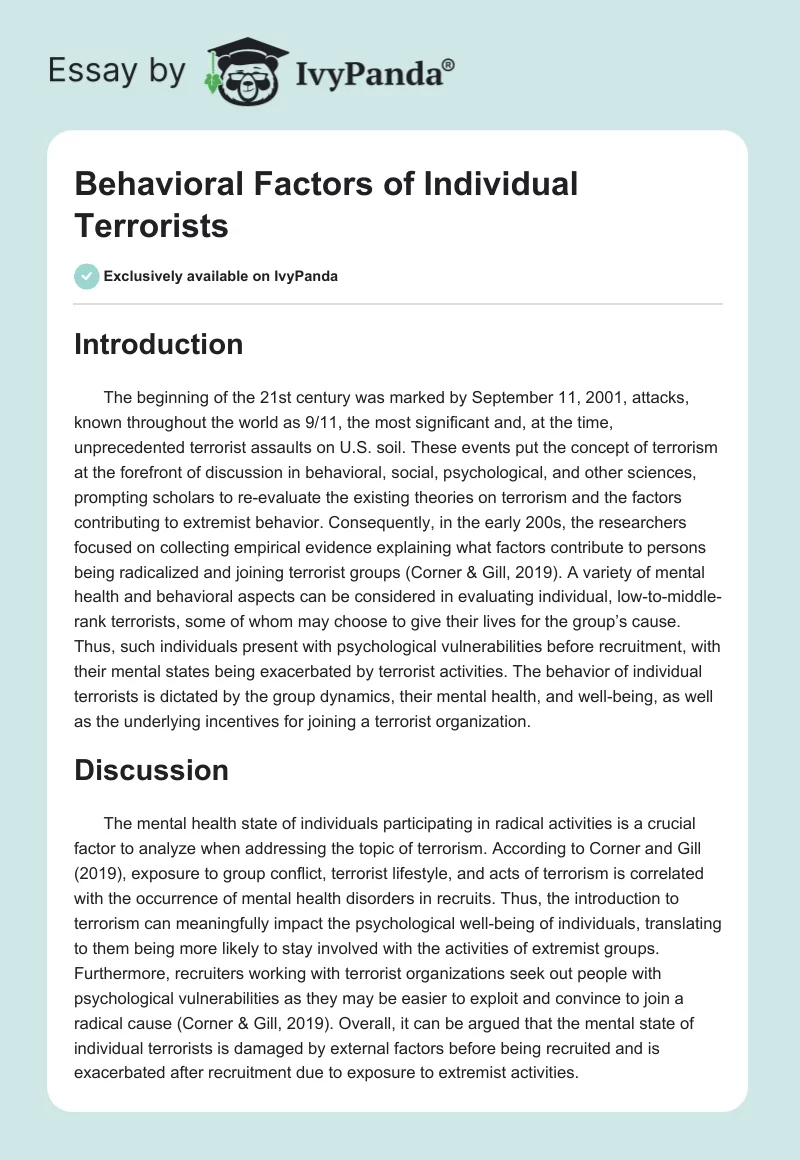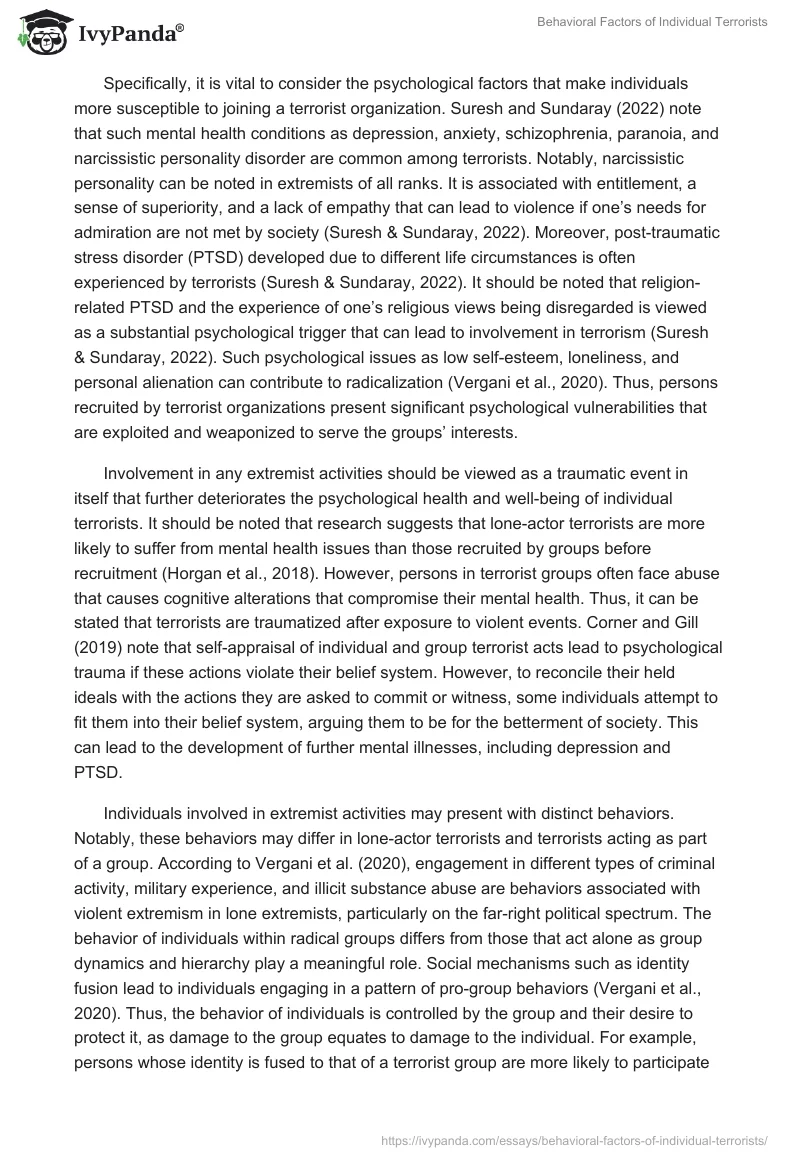Introduction
The beginning of the 21st century was marked by September 11, 2001, attacks, known throughout the world as 9/11, the most significant and, at the time, unprecedented terrorist assaults on U.S. soil. These events put the concept of terrorism at the forefront of discussion in behavioral, social, psychological, and other sciences, prompting scholars to re-evaluate the existing theories on terrorism and the factors contributing to extremist behavior. Consequently, in the early 200s, the researchers focused on collecting empirical evidence explaining what factors contribute to persons being radicalized and joining terrorist groups (Corner & Gill, 2019). A variety of mental health and behavioral aspects can be considered in evaluating individual, low-to-middle-rank terrorists, some of whom may choose to give their lives for the group’s cause. Thus, such individuals present with psychological vulnerabilities before recruitment, with their mental states being exacerbated by terrorist activities. The behavior of individual terrorists is dictated by the group dynamics, their mental health, and well-being, as well as the underlying incentives for joining a terrorist organization.
Discussion
The mental health state of individuals participating in radical activities is a crucial factor to analyze when addressing the topic of terrorism. According to Corner and Gill (2019), exposure to group conflict, terrorist lifestyle, and acts of terrorism is correlated with the occurrence of mental health disorders in recruits. Thus, the introduction to terrorism can meaningfully impact the psychological well-being of individuals, translating to them being more likely to stay involved with the activities of extremist groups. Furthermore, recruiters working with terrorist organizations seek out people with psychological vulnerabilities as they may be easier to exploit and convince to join a radical cause (Corner & Gill, 2019). Overall, it can be argued that the mental state of individual terrorists is damaged by external factors before being recruited and is exacerbated after recruitment due to exposure to extremist activities.
Specifically, it is vital to consider the psychological factors that make individuals more susceptible to joining a terrorist organization. Suresh and Sundaray (2022) note that such mental health conditions as depression, anxiety, schizophrenia, paranoia, and narcissistic personality disorder are common among terrorists. Notably, narcissistic personality can be noted in extremists of all ranks. It is associated with entitlement, a sense of superiority, and a lack of empathy that can lead to violence if one’s needs for admiration are not met by society (Suresh & Sundaray, 2022). Moreover, post-traumatic stress disorder (PTSD) developed due to different life circumstances is often experienced by terrorists (Suresh & Sundaray, 2022). It should be noted that religion-related PTSD and the experience of one’s religious views being disregarded is viewed as a substantial psychological trigger that can lead to involvement in terrorism (Suresh & Sundaray, 2022). Such psychological issues as low self-esteem, loneliness, and personal alienation can contribute to radicalization (Vergani et al., 2020). Thus, persons recruited by terrorist organizations present significant psychological vulnerabilities that are exploited and weaponized to serve the groups’ interests.
Involvement in any extremist activities should be viewed as a traumatic event in itself that further deteriorates the psychological health and well-being of individual terrorists. It should be noted that research suggests that lone-actor terrorists are more likely to suffer from mental health issues than those recruited by groups before recruitment (Horgan et al., 2018). However, persons in terrorist groups often face abuse that causes cognitive alterations that compromise their mental health. Thus, it can be stated that terrorists are traumatized after exposure to violent events. Corner and Gill (2019) note that self-appraisal of individual and group terrorist acts lead to psychological trauma if these actions violate their belief system. However, to reconcile their held ideals with the actions they are asked to commit or witness, some individuals attempt to fit them into their belief system, arguing them to be for the betterment of society. This can lead to the development of further mental illnesses, including depression and PTSD.
Individuals involved in extremist activities may present with distinct behaviors. Notably, these behaviors may differ in lone-actor terrorists and terrorists acting as part of a group. According to Vergani et al. (2020), engagement in different types of criminal activity, military experience, and illicit substance abuse are behaviors associated with violent extremism in lone extremists, particularly on the far-right political spectrum. The behavior of individuals within radical groups differs from those that act alone as group dynamics and hierarchy play a meaningful role. Social mechanisms such as identity fusion lead to individuals engaging in a pattern of pro-group behaviors (Vergani et al., 2020). Thus, the behavior of individuals is controlled by the group and their desire to protect it, as damage to the group equates to damage to the individual. For example, persons whose identity is fused to that of a terrorist group are more likely to participate in physical fights and other extreme behaviors to defend the group and its beliefs. Overall, group dynamics lead to people participating in behaviors dictated by the necessities of the group.
It should be noted that the psychological and behavioral factors of individual terrorists, including those acting alone and in a group, are highly correlated. The mental state of terrorists affects the choices they make and what patterns of behavior they find appropriate in different situations. Thus, as many terrorist organizations recruit psychologically vulnerable people, their behavior is meaningfully impacted by their mental health. In addition, Horgan et al. (2018) imply that the behavior of terrorists is affected by the underlying incentives they hope to gain from involvement in extremist activity. As motivations to join a radical group may vary from religious to economic, the behavioral patterns are “related to the incentives that drove their original involvement in a terrorist organization” (Horgan et al., 2018, p. 98). For instance, individuals that search for social acceptance and belonging are more likely to exhibit pro-group behaviors, while religious motivation manifests through increased adherence to one’s faith. Thus, the behavior of individual terrorists is determined mainly by their mental state and inherent motivations.
Conclusion
In summary, terrorism is a topic that should be thoroughly researched to equip relevant authorities and agencies to combat it. The understanding of the behavioral and psychological factors of individual terrorists is crucial, as it can help predict and prevent extremist acts from taking place. Overall, the innate psychological vulnerability of recruits and the adverse impact of terrorist organizations on the mental health of individuals should be emphasized. The behavior of terrorists is controlled through the establishment of a strong group identity and its fusion with the identity of the individuals as well as their mental state and innate motivations for terrorism engagement.
References
Corner, E., & Gill, P. (2020). Psychological distress, terrorist involvement and disengagement from terrorism: A sequence analysis approach. Journal of Quantitative Criminology, 36(3), 499–526.
Horgan, J., Shortland, N., & Abbasciano, S. (2018). Towards a typology of terrorism involvement: A behavioral differentiation of violent extremist offenders. Journal of Threat Assessment and Management, 5(2), 84–102.
Suresh, S., & Sundaray, A. (2022). Ordeal factors to interpret terrorists: A concrete understanding on PTSD and correlated triggers. Gap Indian Journal of Forensics and Behavioural Sciences, 3(1), 1–9.
Vergani, M., Iqbal, M., Ilbahar, E., & Barton, G. (2020). The three Ps of radicalization: Push, pull and personal. A systematic scoping review of the scientific evidence about radicalization into violent extremism. Studies in Conflict & Terrorism, 43(10), 854–854.


